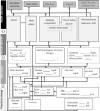Prevention of cardiovascular disease, a major non-communicable disease, in a super-aging society: Health success and unsolved issues in Japan
- PMID: 38450114
- PMCID: PMC10912808
- DOI: 10.35772/ghm.2023.01130
Prevention of cardiovascular disease, a major non-communicable disease, in a super-aging society: Health success and unsolved issues in Japan
Abstract
As far as non-communicable disease is concerned, Japan is unique in showing a substantial decline in stroke mortality and the lowest and declining mortality from ischemic heart disease during the past half century, which contributed to the elongation of a 4-year average life expectancy, leading to top longevity in the world. However, several issues have remained in the prevention of cardiovascular disease with super-aging: i) how to manage the screening and lifestyle modification for both individuals with metabolic syndrome and those with non-overweight/ obesity plus metabolic risk factors, and ii) how to enhance the referral of very high-risk individuals screened at health checks to physicians for seeking treatment and examine whether an early clinical visit was associated with a lower risk of cardiovascular disease and total mortality. Health counseling is needed for both persons with metabolic syndrome and high-risk individuals with non-obese/overweight because the population attributable risk fraction of ischemic cardiovascular disease was similar for both high-risk individuals. Standardized counseling for very high-risk individuals accelerated clinical visits and reduced levels of risk factors. In health counseling, public health nurses were more effective in increasing clinic visits. Furthermore, the earlier clinic visit after the counseling suggested a lower risk of hospitalization for stroke, coronary heart disease, heart failure, and all-cause mortality. This article reviews these epidemiological findings for health practitioners and policymakers to perform further prevention and control for cardiovascular disease in Japan and other Asian and African countries with emerging cardiovascular burden and aging.
Keywords: Japan; cardiovascular disease; epidemiology; metabolic syndrome; prevention; referral.
2024, National Center for Global Health and Medicine.
Conflict of interest statement
The author has no conflicts of interest to disclose.
Figures




References
-
- World Health Organization: The top 10 causes of death. https://www.who.int/news-room/fact-sheets/detail/the-top-10-causes-of-death (accessed December 1, 2023).
-
- Iso H, Maruyama K, Yamagishi K. Chronic diseases and risk factor trends in Japan: Cardiovascular inequalities. In: Health in Japan: Social Epidemiology of Japan since the 1964 Tokyo Olympics (Brunner E, Cable N, Iso H, editors). Oxford University Press. 2020; pp163-178
-
- Ikeda N, Saito E, Kondo N, et al. . What has made the population of Japan healthy? Lancet. 2011; 378:1094-1105. - PubMed
-
- The Ministry of Health, Labour and Welfare. Life Table in 2021. https://www.mhlw.go.jp/toukei/saikin/hw/life/life21/index.html (accessed December 1, 2023). (in Japanese) .
Publication types
LinkOut - more resources
Full Text Sources
Research Materials
Miscellaneous

